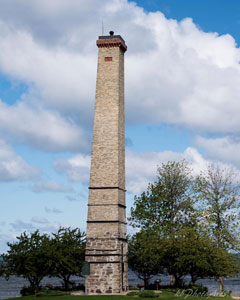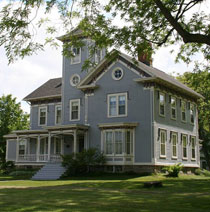Formed in 2012, Friends of the Port Hope Depot is a dedicated group of volunteers who, with the help of the community, have moved the depot from its original location to its new site in Stafford County Park.
The mission of the Friends of the Port Hope Depot is to preserve, maintain and promote the heritage of the Port Hope community through its historic train station. The Depot is a classic example of the stations designed by the railroad company that were economical to build; typical frame construction with board and batten exterior. Inside the original depot was a passenger waiting room, a stationmaster's office, a second service or luggage room and a slightly elevated freight room. Restoration of the interior includes all of the rooms except the freight room. The original baggage room is now a new restroom and kitchenette. The building is ADA compliant and eventually a lift will allow access to the second floor. Although restoration continues on the inside, the the Depot was officially dedicated on September 15, 2015 as an historic landmark.
- Form a long-term, non-profit organization
- Develop a budget and secure funding
- Acquire the building proper
- Secure a suitable and appropriate location
- Move and renovate the structure
- Develop programs and refine uses
The Depot is located just off M25 in Port Hope, Michigan. Turn east on State St. and you’ll find it down the hill and on the right.
To view the Port Hope Depot location in a larger map.
The train depot now sits adjacent to Stafford County Park on the shores of Lake Huron. Plenty of parking, camping and trailer hookups are available at the park.



Located on Lake Huron in Michigan's Thumb, Port Hope truely is The little town with the Big WELCOME!
Phone 989-428-4554 - email - Don Finkel
Stafford County Park is located on Lake Huron in “The Little Town With the Big Welcome”, Port Hope, MI. Stafford County Park features 73 sites & 6 camper cabins on 38 acres.
Michigan’s Thumb Area includes the counties of Huron, Sanilac and Tuscola, and is outlined by the Saginaw Bay and Lake Huron. The Thumb Area is a great ‘staycation’ for Michiganders and Canadians. We’re just a short drive north of the metro Detroit area and only a half hour east of the Great Lakes Bay region.
Along the eastern shores of Michigan lies a collection of communities that are boastful about the color blue. 140 miles of shoreline unites the quaint towns of Clay, Algonac, Marine City, St. Clair, Port Huron, Lexington, Port Sanilac, Harbor Beach and Port Austin.
The place where Pure Michigan travel comes first. Here Pure Michigan tourism lets unspoiled nature and authentic character revive our spirits.
The Pointe aux Barques Keeper's house and tower have been completely restored and contain history and artifacts from a bygone era. The Museum is open to the public free of charge with donations kindly appreciated to help fund the Society's projects.
The Society helps to connect Michigan’s past to students, educators, historical organizations and the public through educational programs, conferences, publications, awards, workshops, referral services, networking opportunities, and support for local history organizations.
The Mission of the Tip of The Thumb Heritage Water Trail is to develop, maintain, and promote a water trail that highlights natural, cultural, and historical attributes to drive tourism, economic development, and recreational opportunities in Huron, Sanilac, and Tuscola Counties.
Memorial Day to Oct. 1st.
Sat., 10 - 4 and Sun., 1 - 4